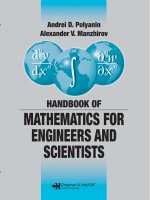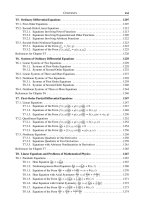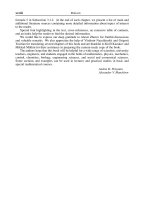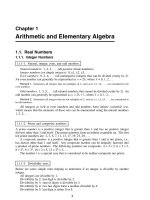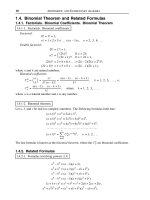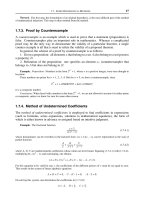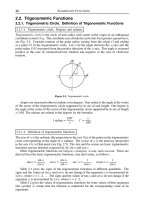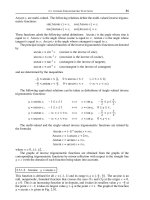Handbook of mathematics for engineers and scienteists part 26 ppsx
Bạn đang xem bản rút gọn của tài liệu. Xem và tải ngay bản đầy đủ của tài liệu tại đây (453.6 KB, 7 trang )
4.7. QUADRIC SURFACES (QUADRICS) 143
The distance between them can be calculated by the formula
d =
[(r
1
– r
2
)R
1
R
2
]
|R
1
× R
2
|
=
x
1
– x
2
y
1
– y
2
z
1
– z
2
l
1
m
1
n
1
l
2
m
2
n
2
l
1
m
1
l
2
m
2
2
+
m
1
n
1
m
2
n
2
2
+
n
1
l
1
n
2
l
2
2
.(4.6.3.30)
The condition that the determinant in the numerator in (4.6.3.30) is zero is the condition for
the two lines in space to meet.
Remark 1. The numerator of the fraction in (4.6.3.30) is the volume of the parallelepiped spanned by the
vectors r
1
– r
2
, R
1
,andR
2
, while the denominator of the fraction is the area of its base. Hence the fraction
itself is the altitude d of this parallelepiped.
Remark 2. If the lines are parallel (i.e., l
1
= l
2
= l, m
1
= m
2
= m,andn
1
= n
2
= n,orR
1
= R
2
= R),
then the distance between them should be calculated by formula (4.6.3.29) with r
0
replaced by r
2
.
4.7. Quadric Surfaces (Quadrics)
4.7.1. Quadrics (Canonical Equations)
4.7.1-1. Central surfaces.
A segment joining two points of a surface is called a chord. If there exists a point in space,
not necessarily lying on the surface, that bisects all chords passing through it, then the
surface is said to be central and the point is called the center of the surface.
The equations listed below in Paragraphs 4.7.1-2 to 4.7.1-4 for central surfaces are given
in canonical form; i.e., the center of a surface is at the origin, and the surface symmetry
axes are the coordinate axes. Moreover, the coordinate planes are symmetry planes.
4.7.1-2. Ellipsoid.
An ellipsoid is a surface defined by the equation
x
2
a
2
+
y
2
b
2
+
z
2
c
2
= 1,(4.7.1.1)
where the numbers a, b,andc are the lengths of the segments called the semiaxes of the
ellipsoid (see Fig 4.52a).
Y
Y
ZZ()a ()b
X
X
a
a
a
a
b
b
c
c
b
b
c
c
O
O
Figure 4.52. Triaxial ellipsoid (a) and spheroid (b).
144 ANALYTIC GEOMETRY
If a ≠ b ≠ c, then the ellipsoid is said to be triaxial,orscalene.Ifa = b ≠ c, then the
ellipsoid is called a spheroid; it can be obtained by rotating the ellipse x
2
/a
2
+ z
2
/c
2
= 1,
y = 0 lying in the plane OXZ about the axis OZ (see Fig. 4.52b). If a = b > c, then the
ellipsoid is an oblate spheroid,andifa = b < c, then the ellipsoid is a prolate spheroid.If
a = b = c, then the ellipsoid is the sphere of radius a given by the equation x
2
+ y
2
+ z
2
= a
2
.
An arbitrary plane section of an ellipsoid is an ellipse (in a special case, a circle). The
volume of an ellipsoid is equal to V =
4
3
πabc.
Remark. About the sphere, see also Paragraph 3.2.3-3.
4.7.1-3. Hyperboloids.
A one-sheeted hyperboloid is a surface defined by the equation
x
2
a
2
+
y
2
b
2
–
z
2
c
2
= 1,(4.7.1.2)
where a and b are the real semiaxes and c is the imaginary semiaxis (see Fig. 4.53a).
A two-sheeted hyperboloid is a surface defined by the equation
x
2
a
2
+
y
2
b
2
–
z
2
c
2
=–1,(4.7.1.3)
where c is the real semiaxis and a and b are the imaginary semiaxes (see Fig 4.53b).
Y
Y
ZZ()a ()b
X
X
a
c
b
O
O
c
Figure 4.53. One-sheeted (a) and two-sheeted (b) hyperboloids.
A hyperboloid approaches the surface
x
2
a
2
+
y
2
b
2
–
z
2
c
2
= 0,
which is called an asymptotic cone,infinitely closely.
A plane passing through the axis OZ intersects each of the hyperboloids (4.7.1.2) and
(4.7.1.3) in two hyperbolas and the asymptotic cone in two straight lines, which are the
4.7. QUADRIC SURFACES (QUADRICS) 145
Y
Z
X
a
c
b
O
Figure 4.54. A cone.
asymptotes of these hyperbolas. The section of a hyperboloid by a plane parallel to OXY
is an ellipse. The section of a one-sheeted hyperboloid by the plane z = 0 is an ellipse,
which is called the gorge or throat ellipse.
For a = b, we deal with the hyperboloid of revolution obtained by rotating a hyperbola
with semiaxes a and c about its focal axis 2c (which is an imaginary axis for a one-sheeted
hyperboloid and a real axis for a two-sheeted hyperboloid). If a = b = c, then the hyperboloid
of revolution is said to be right, and its sections by the planes OXZ and OY Z are equilateral
hyperbolas.
A one-sheeted hyperboloid is a ruled surface (see Paragraph 4.7.1-6).
4.7.1-4. Cone.
A cone is a surface defined by the equation
x
2
a
2
+
y
2
b
2
–
z
2
c
2
= 0.(4.7.1.4)
The cone (see Fig. 4.54) defined by (4.7.1.4) has vertex at the origin, and for its base we
can take the ellipse with semiaxes a and b in the plane perpendicular to the axis OZ at the
distance c from the origin. This cone is the asymptotic cone for the hyperboloids (4.7.1.2)
and (4.7.1.3). For a = b, we obtain a right circular cone.
A cone is a ruled surface (see Paragraph 4.7.1-6).
Remark. About the cone, see also Paragraph 3.2.3-2.
4.7.1-5. Paraboloids.
In contrast to the surfaces considered above, paraboloids are not central surfaces. For the
equations listed below, the vertex of a paraboloid lies at the origin, the axis OZ is the
symmetry axis, and the planes OXZ and OY Z are symmetry planes.
An elliptic paraboloid (see Fig 4.55a) is a surface defined by the equation
x
2
p
+
y
2
q
= 2z,(4.7.1.5)
146 ANALYTIC GEOMETRY
where p > 0 and q > 0 are parameters.
Y
Y
ZZ()a ()b
X
X
O
O
Figure 4.55. Elliptic (a) and hyperbolic (b) paraboloids.
The sections of an elliptic paraboloid by planes parallel to the axis OZ are parabolas,
and the sections by planes parallel to the plane OXY are ellipses. For example, let the
parabola x
2
= 2pz, y = 0, obtained by the section of an elliptic paraboloid by the plane
OXZ be fixed and used as the directrix, and let the parabola x
2
= 2qz, x = 0, obtained by the
section of the elliptic paraboloid by the plane OY Z be movable and used as the generator.
Then the paraboloid can be obtained by parallel translation of the movable parabola (the
generator) in a given direction along the fixed parabola (the directrix).
If p = q,thenwehaveaparaboloid of revolution, which is obtained by rotating the
parabola 2pz = x
2
lying in the plane OXZ about its axis.
The volume of the part of an elliptic paraboloid cut by the plane perpendicular to its
axis at a height h is equal to V =
1
2
πabh, i.e., half the volume of the elliptic cylinder with
the same base and altitude.
A hyperbolic paraboloid (see Fig 4.55b) is a surface defined by the equation
x
2
p
–
y
2
q
= 2z,(4.7.1.6)
where p > 0 and q > 0 are parameters.
The sections of a hyperbolic paraboloid by planes parallel to the axis OZ are parabolas,
and the sections by planes parallel to the plane OXY are hyperbolas. For example, let the
parabola x
2
= 2pz, y = 0, obtained by the section of the hyperbolic paraboloid by the plane
OXZ be fixed and used as the directrix, and let the parabola x
2
=–2qz, x = 0, obtained
by the section of the hyperbolic paraboloid by the plane OY Z be movable and used as
the generator. Then the paraboloid can be obtained by parallel translation of the movable
parabola (the generator) in a given direction along the fixed parabola (the directrix).
A hyperbolic paraboloid is a ruled surface (see Paragraph 4.7.1-6).
4.7.1-6. Rulings of ruled surfaces.
A ruled surface is a surface swept out by a moving line in space. The straight lines
forming a ruled surface are called rulings. Examples of ruled surfaces include the cone
(see Paragraph 3.2.3-2 and 4.7.1-4), the cylinder (see Paragraph 3.2.3-1), the one-sheeted
hyperboloid (see Paragraph 4.7.1-3), and the hyperbolic paraboloid (see Paragraph 4.7.1-5).
4.7. QUADRIC SURFACES (QUADRICS) 147
The cone (4.7.1.4) has one family of rulings,
αx = βy,
α
2
a
2
+ β
2
b
2
ab
x =
β
c
z.
Properties of rulings of the cone:
1. There is a unique ruling through each point of the cone.
2. Two arbitrary distinct rulings of the cone meet at the point O(0, 0, 0).
3. Three pairwise distinct rulings of the cone are not parallel to any plane.
The one-sheeted hyperboloid (4.7.1.2) has two families of rulings:
α
x
a
+
z
c
= β
1 +
y
b
, β
x
a
–
z
c
= α
1 –
y
b
;
γ
x
a
+
z
c
= δ
1 –
y
b
, δ
x
a
–
z
c
= γ
1 +
y
b
.
(4.7.1.7)
One of these families is shown in Fig. 4.56a.
Y
Y
ZZ
()a ()b
X
X
O
O
Figure 4.56. Families of rulings for one-sheeted hyperboloid (a) and for hyperbolic paraboloid (b).
Properties of rulings of the one-sheeted hyperboloid:
1. In either family, there is a unique ruling through each point of the one-sheeted hyper-
boloid.
2. Any two rulings in different families lie in a single plane.
3. Any two distinct rulings in the same family are skew.
4. Three distinct rulings in the same family are not parallel to any plane.
The hyperbolic paraboloid (4.7.1.6) has two families of rulings:
α
x
√
p
+
y
√
q
= 2β, β
x
√
p
–
y
√
q
= αz;
γ
x
√
p
+
y
√
q
= δz, δ
x
√
p
–
y
√
q
= 2γ.
(4.7.1.8)
One of these families is shown in Fig. 4.56b.
148 ANALYTIC GEOMETRY
Properties of rulings of a hyperbolic paraboloid:
1. In either family, there is a unique ruling through each point of the hyperbolic paraboloid.
2. Any two rulings in different families lie in a single plane and meet.
3. Any two distinct rulings in the same family are skew.
4. All rulings in either family are parallel to a single plane.
4.7.2. Quadrics (General Theory)
4.7.2-1. General equation of quadric.
A quadric is a set of points in three-dimensional space whose coordinates in the rectangular
Cartesian coordinate system satisfy a second-order algebraic equation
a
11
x
2
+ a
22
y
2
+ a
33
z
2
+ 2a
12
xy + 2a
13
xz + 2a
23
yz
+ 2a
14
x + 2a
24
y + 2a
34
z + a
44
= 0,(4.7.2.1)
or
(a
11
x + a
12
y + a
13
z + a
14
)x +(a
21
x + a
22
y + a
23
z + a
24
)y
+(a
31
x + a
32
y + a
33
z + a
34
)z + a
41
x + a
42
y + a
43
z + a
44
= 0,
where a
ij
= a
ji
(i, j = 1, 2, 3, 4). If equation (4.7.2.1) does not define a real geometric
object, then one says that this equation defines an imaginary quadric. Equation (4.7.2.1) in
vector form reads
(Ar) ⋅ r + 2a ⋅ r + a
44
= 0,(4.7.2.2)
where A is the affinor with coordinates A
i
j
= a
ij
and a is the vector with coordinates a
i
= a
i4
.
4.7.2-2. Classification of quadrics.
There exists a rectangular Cartesian coordinate system in which equation (4.7.2.1), depend-
ing on the coefficients, has 1 of 17 canonical forms, each of which is associated with a
certain class of quadrics (see Table 4.3).
4.7.2-3. Invariants of quadrics.
The shape of a quadric can be determined by using four invariants and two semi-invariants
without reducing equation (4.7.2.1) to canonical form.
The main invariants are the quantities
S = a
11
+ a
22
+ a
33
,(4.7.2.3)
T =
a
11
a
12
a
21
a
22
+
a
11
a
13
a
31
a
33
+
a
22
a
23
a
23
a
33
,(4.7.2.4)
δ =
a
11
a
12
a
13
a
12
a
22
a
23
a
13
a
23
a
33
,(4.7.2.5)
Δ =
a
11
a
12
a
13
a
14
a
12
a
22
a
23
a
24
a
13
a
23
a
33
a
34
a
14
a
24
a
34
a
44
,(4.7.2.6)
whose values are preserved under parallel translations and rotations of the coordinate axes.
4.7. QUADRIC SURFACES (QUADRICS) 149
TABLE 4.3
Canonical equations and classes of quadrics
No. Surface
Canonical equation Type
Class
Irreducible surfaces
1
Ellipsoid
x
2
a
2
+
y
2
b
2
+
z
2
c
2
= 1
Elliptic
2
Imaginary ellipsoid
x
2
a
2
+
y
2
b
2
+
z
2
c
2
=–1
3
One-sheeted hyperboloid
x
2
a
2
+
y
2
b
2
–
z
2
c
2
= 1
Hyperbolic Nondegenerate
4
Two-sheeted hyperboloid
x
2
a
2
+
y
2
b
2
–
z
2
c
2
=–1
5
Elliptic paraboloid
x
2
p
+
y
2
q
= 2z
Parabolic
(p > 0, q > 0)
6
Hyperbolic paraboloid
x
2
p
–
y
2
q
= 2z
7
Elliptic cylinder
x
2
a
2
+
y
2
b
2
= 1
8
Imaginary elliptic cylinder
x
2
a
2
+
y
2
b
2
=–1
Cylindrical
9
Hyperbolic cylinder
x
2
a
2
–
y
2
b
2
= 1
Degenerate
10
Parabolic cylinder
y
2
= 2px
11
Real cone
x
2
a
2
+
y
2
b
2
–
z
2
c
2
= 0
Conic
12
Imaginary cone with real vertex
x
2
a
2
+
y
2
b
2
+
z
2
c
2
= 0
Reducible surfaces
13
Pair of real intersecting planes
x
2
a
2
–
y
2
b
2
= 0
14
Pair of imaginary planes
intersecting in a real straight line
x
2
a
2
+
y
2
b
2
= 0
Pairs of planes Degenerate
15
Pair of real parallel planes
x
2
= a
2
16
Pair of imaginary parallel planes
x
2
=–a
2
17
Pair of real coinciding planes
x
2
= 0
The semi-invariants are the quantities
σ = Δ
11
+ Δ
22
+ Δ
33
,(4.7.2.7)
Σ =
a
11
a
14
a
41
a
44
+
a
22
a
24
a
42
a
44
+
a
33
a
34
a
44
a
44
,(4.7.2.8)
whose values are preserved only under rotations of the coordinate axes. Here Δ
ij
is the
cofactor of the entry a
ij
in Δ.
The classification of quadrics based on the invariants S, T , δ,andΔ and the semi-
invariants σ and Σ is given in Tables 4.4 and 4.5.
